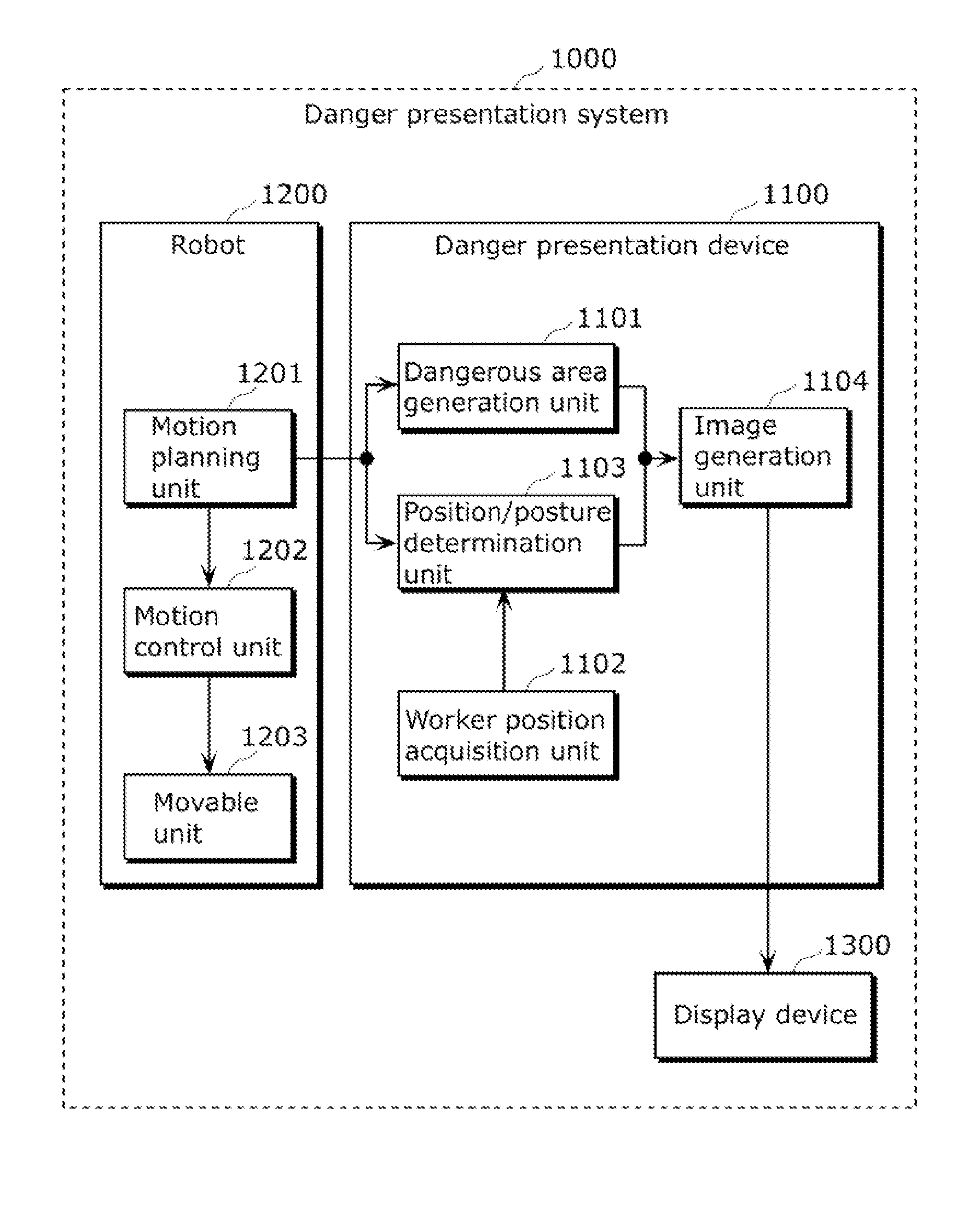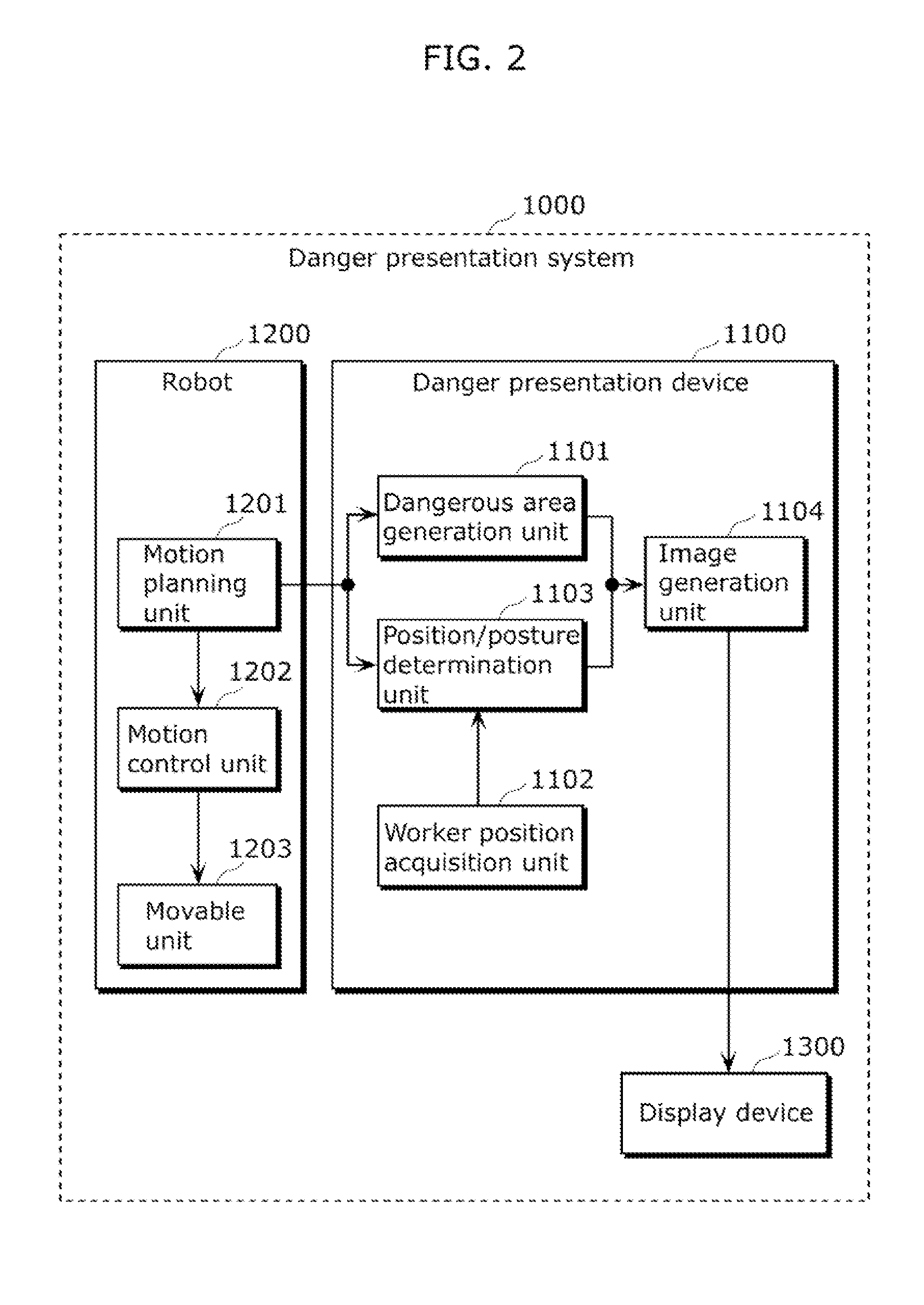Danger presentation device, danger presentation system, danger presentation method and program
a technology of danger presentation and danger area, which is applied in the direction of programme-controlled manipulators, programme control, instruments, etc., can solve the problems of preventing the smooth operation of robots, dangerous areas may not and dangerous areas cannot be appropriately recognized by workers
- Summary
- Abstract
- Description
- Claims
- Application Information
AI Technical Summary
Benefits of technology
Problems solved by technology
Method used
Image
Examples
embodiment 1
[0102]A danger presentation system in Embodiment 1 presents a dangerous area to a worker so that the worker in the dangerous area can recognize the direction in which a robot is approaching the worker. The danger presentation system in Embodiment 1 is for a rotary robot with one degree of freedom. A robot with one degree of freedom is an example of the robots to which the present invention is directed. The robots to which the present invention is directed include a robot with multiple degrees of freedom, a linear movement robot, a mobile robot, and a robot in combination thereof.
[0103]FIG. 1 is a conceptual diagram of the danger presentation system in Embodiment 1. The danger presentation system 1000 illustrated in FIG. 1 includes a danger presentation device 1100, a robot 1200, and a display device 1300. The danger presentation system 1000 projects a dangerous area 31 to the floor around a robot 1200. The danger presentation system 1000 projects the posture of the robot 1200 at a s...
embodiment 2
[0155]The danger presentation system in Embodiment 1 presents a dangerous area to a worker in the dangerous area. The dangerous presentation system in Embodiment 2 further presents a dangerous area to a worker who is currently not in the dangerous area, but may move to the dangerous area later.
[0156]FIG. 9 is a general diagram of the dangerous presentation system in Embodiment 2. A dangerous presentation system 1010 in Embodiment 2 includes a danger presentation device 1110, a robot 1200, and a display device 1300. The dangerous presentation device 1110 includes a position / posture determination unit 1113 whose operation is different from the operation of the position / posture determination unit 1103 in Embodiment 1. Other components are the same as those of Embodiment 1, and description is omitted.
[0157]FIG. 10 is a flowchart illustrating the process of determination of a collision position for presentation, the determination being made by the position / posture determination unit 1113...
embodiment 3
[0172]When there is possibility of collision between a worker and a robot, the danger presentation system in Embodiment 1 and Embodiment 2 displays, as a characteristic position, a certain place where the worker may collide with the robot at an earliest possible time, or presents the posture of the robot at the time of collision as a characteristic posture. However, the worker may not be able to view the presented characteristic position or characteristic posture depending on the direction in which the worker faces. The danger presentation system in Embodiment 3 presents a characteristic position or a characteristic posture in the area which can be viewed by a worker in consideration of the direction in which the worker faces.
[0173]FIG. 12 is a general diagram of a danger presentation system 1020 in Embodiment 3. The danger presentation system 1020 in Embodiment 3 includes a danger presentation device 1120, a robot 1200, a display device 1300, and a warning sound output device 1400....
PUM
 Login to View More
Login to View More Abstract
Description
Claims
Application Information
 Login to View More
Login to View More - R&D
- Intellectual Property
- Life Sciences
- Materials
- Tech Scout
- Unparalleled Data Quality
- Higher Quality Content
- 60% Fewer Hallucinations
Browse by: Latest US Patents, China's latest patents, Technical Efficacy Thesaurus, Application Domain, Technology Topic, Popular Technical Reports.
© 2025 PatSnap. All rights reserved.Legal|Privacy policy|Modern Slavery Act Transparency Statement|Sitemap|About US| Contact US: help@patsnap.com



